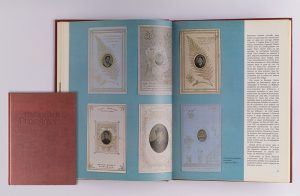Documento Mês – Fundo Bibliográfico
“Ferrotypes présentés em format «cart de visite»”

“Ferrotypes présentés em format «cart de visite»”.
Histoire De La Photographie, 42-43.
Paris: Princesse
Tinha conhecimento que pela fragilidade do vidro, o ambrótipo foi substituído pelo ferrótipo?
Em 1852 surge o ambrótipo, que consiste num negativo de vidro (suporte fotográfico), revestido de um lado com veludo ou cartão preto e que faz a imagem aparecer como se fosse um positivo. As características físicas do vidro, como a resistência e a transparência popularizaram-no na fotografia. No entanto, o vidro apesar de ser um material inerte, é frágil e quebradiço e o acondicionamento indevido levava muitas vezes à quebra com consequente perda da imagem.
Os ambrótipos tiveram sucesso durante muitos anos, até que foram gradualmente sendo substituídos por um processo mais rápido e económico, o ferrótipo, que foi patenteado em 1856 pelo norte-americano Hamilton Smith. As imagens eram formadas numa superfície de ferro muito fino previamente pintada de preto e coberta com uma camada fina de colódio sensibilizado. A principal diferença entre o ambrótipo e o ferrótipo é a substituição do suporte de vidro por uma chapa de ferro. O ferrótipo era mais fácil de transportar e enviar pelo correio para além de ser mais resistente, uma vez que a chapa de ferro era inquebrável e fácil de cortar em qualquer formato.
Did you know that the ambrotype was replaced by the ferrotype due to the fragility of glass?
The ambrotype appeared in 1852. It consisted of a glass negative (photographic support), coated on one side with velvet or black cardboard and making the image appear as if it were a positive. The physical characteristics of glass, such as its resistance and transparency, made it popular in photography. However, despite being an inert material, glass is fragile and brittle and improper packaging often caused it to break, meaning that the image would be lost.
Ambrotypes were successful for many years, until they were gradually replaced by a faster and cheaper process – the ferrotype -, which was patented in 1856 by the American chemistry and physics professor Hamilton Smith. The images were formed on a very thin iron surface previously painted black and covered with a thin layer of sensitised collodion. The main difference between the ambrotype and the ferrotype is the replacement of the glass support by an iron plate. The ferrotype was easier to carry and send by mail and more durable, as the iron plate was unbreakable and easy to cut into any shape.